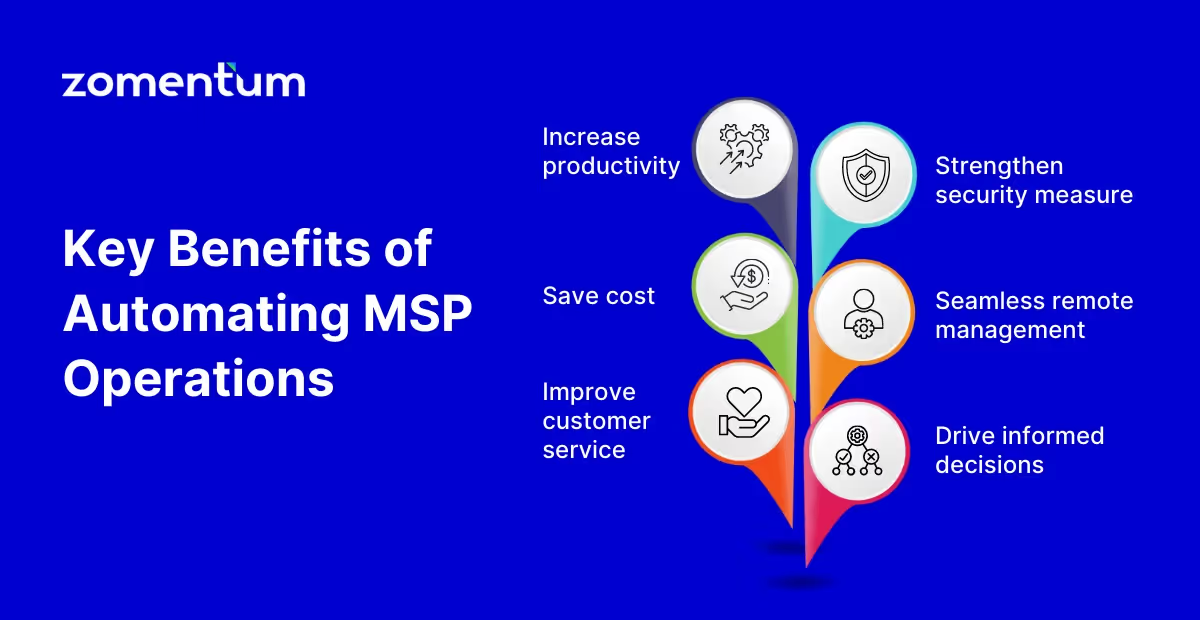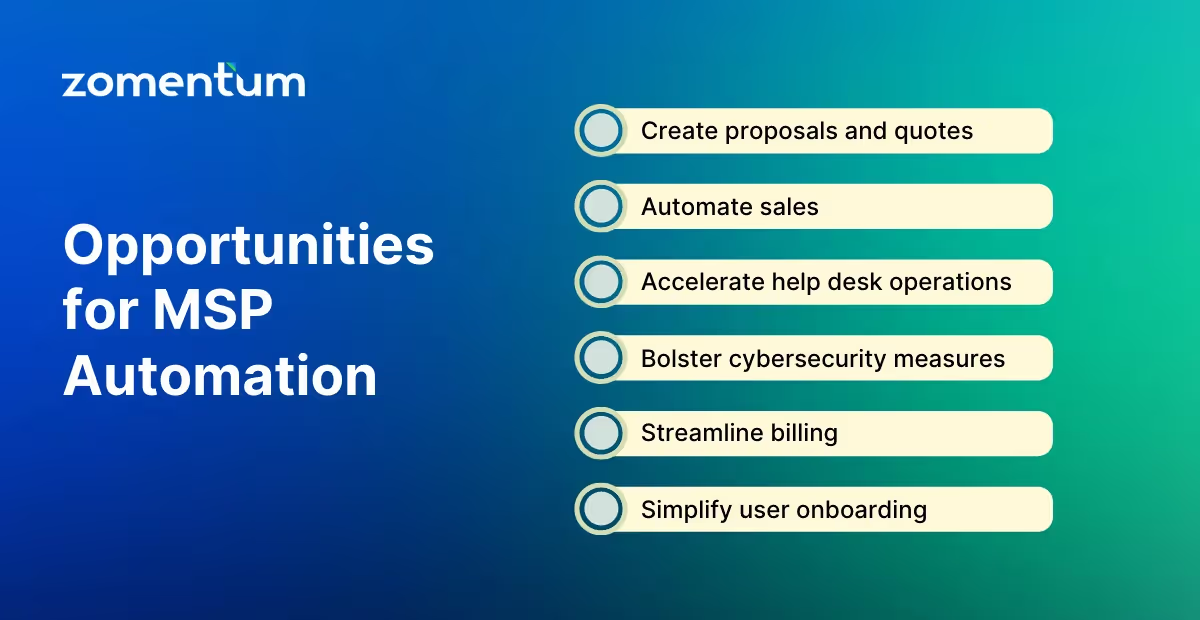Complete Guide to MSP Automation

In an ever-evolving digital world, the challenges for Managed Service Providers (MSPs) have never been greater. From meeting increasingly complex customer demands, to ensuring robust security protocols, and managing a myriad of tasks, MSPs are often in a race against time. The key to not just surviving, but thriving in this dynamic landscape? MSP Automation.
A study by Grand View Research predicts the global automation market to scale a staggering $328.2 billion by 2025, demonstrating how vital automation is for staying competitive.
As MSPs face escalating IT complexities, automation is emerging as an indispensable tool, enhancing service quality and driving productivity by allowing more focus on strategic value-driven initiatives. But the road to full-scale MSP automation is challenging. Where to begin? What to automate? How to gauge success? The answers aren't always clear.
In this guide, we’ll dive deep into some actionable strategies and critical insights to help your MSP business navigate the complexities of automation, unleashing potential for unparalleled growth and profitability.
Whether you're an MSP planning your first foray into automation or looking to optimize current systems, our guide demystifies the process.
What is MSP Automation?
MSP automation refers to the strategic implementation of technology and tools to automate various operations and workflows within Managed Service Providers (MSP) firms. It involves leveraging automation to streamline tasks such as patch management, system monitoring, backup and recovery, and more, or streamline growth functions like sales
By embracing MSP automation, service providers can proactively monitor their client's IT infrastructure and detect and address potential problems before they escalate. In fact, MSPs can identify and resolve issues even before the client becomes aware of them.
Consider a practical scenario: an automation tool detects an issue within a client's system. It instantly alerts the MSP support team and generates a ticket in their tracking system. This centralized platform enables the support team to efficiently monitor and manage customer problems. The automation tool can even generate documentation or pre-set responses, empowering the support staff to take immediate action. This not only enhances the speed of issue resolution but also improves the quality of service, making MSP automation an indispensable strategy in the modern IT services landscape.
What are the Benefits of MSP automation?
MSP automation is more than a productivity tool; it's a strategic enabler that can transform the way Managed Service Providers operate, bringing substantial benefits to their business and clients. By automating routine tasks and leveraging technology effectively, MSPs can streamline their operations and provide superior service to their clients.
Here's how automation can unlock significant advantages for your MSP business:

1. Increases Productivity and Cost Savings
MSP automation excels at performing repetitive tasks accurately and quickly. By reducing manual processes, MSPs can reallocate resources to high-value activities, thereby boosting productivity. It also brings about cost savings as fewer human resources are needed for routine tasks, enhancing the overall operational efficiency.
2. Improves Customer Experience
Automated processes result in rapid response times, quicker problem resolution, and proactive system monitoring. This level of efficiency enhances customer satisfaction and helps in building trust and loyalty among clients, contributing to a memorable customer experience.
3. Strengthens Security Measures
Security remains a top concern for MSPs and clients alike. MSP automation helps bolster security through consistent application of security protocols, prompt patch management, and proactive detection of threats. The minimized risk of human error and the rigorous defense against cyber threats strengthens overall security.
4. Enables Effective Remote Management and Monitoring
With the rise of remote work and distributed teams, MSP automation enables seamless remote management and monitoring. Through automation tools, MSPs can remotely access and monitor client systems, perform updates and maintenance, and resolve issues without the need for physical presence. This flexibility not only improves efficiency but also allows MSPs to provide round-the-clock support to their clients regardless of location.
5. Drives Informed Decision-making
MSP automation tools provide access to accurate, timely, and detailed data, revolutionizing decision-making processes. MSPs can quickly collect, analyze, and interpret vast volumes of data, gaining insights into operations, customer behavior, and network performance.
Real-time data coupled with cloud-based solutions enable MSP leaders to make data-driven decisions, optimizing resource allocation, strategizing initiatives, and driving business growth. With automation facilitating data flow and analysis, leaders can quickly identify areas of improvement, capitalize on emerging opportunities, and stay ahead of the curve.
Opportunities for MSP Automation: Areas to Automate in Your MSP Business

Managed Service Providers (MSPs) can harness the power of automation to revamp and enhance their business operations. Drawing inspiration from several key areas, let's explore how automation can transform your MSP services:
1. Creating Contracts and Proposals
One of the crucial aspects of an MSP's operations includes creating and managing contracts, proposals, and other necessary documents. Automation can help streamline this process, reducing the time and effort required, and ensuring accuracy and consistency. Tools such as Zomentum can assist in designing quotes, proposals, and contracts that win revenue, and automate the entire process, thereby ensuring a smoother and more efficient business operation.
2. Sales Automation
Sales is another critical area where automation can bring in a significant efficiency boost. From lead generation and scoring to managing customer relationships and closing deals, automation can transform every step of the sales process. Platforms like Zomentum provide robust sales automation tools for MSPs to help them automate their sales process, thus saving time, reducing errors, and increasing the overall productivity of the sales team.
3. Enhancing Help Desk Operations
The help desk is often the front line of any MSP business. It's where clients turn when they encounter technological issues. Automating aspects of help desk operations, such as ticket creation and assignment, can dramatically improve service efficiency and responsiveness, resulting in a marked improvement in client satisfaction.
4. Bolstering Cybersecurity Measures
In the current digital age, cybersecurity is paramount. MSPs bear the significant responsibility of safeguarding their clients' data and systems. Automation tools for MSPs can be employed to detect and address security incidents swiftly and efficiently. For example, automated patch management ensures all systems are up-to-date and safeguarded against known vulnerabilities, thus enhancing overall security.
5. Streamlining Billing Processes
Billing is an essential yet often tedious and time-consuming task for MSPs. Automation can help simplify these procedures, reducing the manpower required and ensuring accuracy. Automated billing solutions can decrease the likelihood of errors and ensure timely invoice generation, which can significantly enhance cash flow management.
6. Accelerating Quotation Generation
Creating quotations is another area where automation can bring significant efficiency gains for MSPs. An automated quoting software can produce quotes faster and more accurately than traditional manual methods, saving both time and effort.
7. Simplifying User Onboarding and Offboarding
The process of onboarding new users and offboarding departing ones can often be a cumbersome task for both the client and the service provider, especially when the client utilizes multiple platforms. Automating parts of this process not only saves valuable time but also significantly reduces the risk of errors.
Utilizing lifecycle and identity management platforms enables MSPs to expediently set up new users and revoke access for departing ones across various systems. Such automation doesn't just result in time savings, but also ensures proper management and control over access to client systems.
How to Automate Processes in Your MSP Business?
When it comes to automating processes at your MSP, following a structured approach can lead to successful implementation and maximize the benefits of automation. Here are the key steps to consider:
1. Identify Automation Opportunities
The first stage involves identifying areas within your business where automation can offer the most significant impact. Focus on tasks that are labor-intensive, repetitive, or overly complex - these typically consume a large portion of your team's resources and are prime candidates for automation. To select these, consider:
- Targeting High-Volume Tasks: Identify high-volume, rules-based tasks that automation could streamline, thereby reducing labor costs. According to Bain & Company, automation could result in an average cost reduction of 20%. Pinpointing these tasks can help prioritize automation efforts for maximum efficiency.
- Simplifying Complex Workflows: Analyze your workflows to find complex or tedious tasks. Automating these tasks can free up your team's time for more strategic work. Encourage employee input to understand which tasks are most challenging and ripe for automation.
- Integrating Software Platforms: Evaluate your current software utilization, looking for areas where manual intervention bridges gaps between platforms. Automating these points of interaction can facilitate direct software-to-software communication, eliminating staff mediators.
- Enhancing Communication and Knowledge Sharing: Search for avenues to improve communication and knowledge sharing. Automating information exchange can streamline workflows across different departments.
- Encouraging Innovation: Find areas where you want to foster creativity and growth. Automation can be used as a tool to generate ideas, synthesize information, or develop innovative solutions.
2. Set Objectives and Goals
Define clear objectives for your automation efforts. Whether it's reducing response times, streamlining operations, or improving customer satisfaction, setting specific, measurable goals helps track progress and measure the value of automation.
3. Choose the Right MSP Automation Platform
Opting for the right automation platform provides your MSP with tools that optimize operations, streamline workflows, and improve service delivery. Consider platforms like Zomentum that offer features tailored specifically for MSPs, such as sales automation, proposal management, and contract creation.
4. Onboard and Train Your Team
Prepare your team for the transition to automation. This involves introducing the automated workflows, providing comprehensive training, and reinforcing the benefits of automation with real-world examples. Promote a learning environment that encourages collaboration, addresses concerns, and seeks feedback for improvement.
5. Evaluate and Optimize Workflows
Regularly monitor the performance of your automated workflows. Track key performance indicators (KPIs) related to your automation goals, such as response times, task completion rates, or customer satisfaction scores. Identify bottlenecks or areas for improvement and make necessary adjustments to optimize the automated processes further. Continuous evaluation and optimization will ensure that your automation efforts consistently drive efficiency and deliver desired outcomes.
Unlock the Full Potential of MSP Automation With Zomentum!
Automation is a game-changer for MSP businesses. By implementing MSP automation, you can streamline your operations, enhance service quality, and optimize resources. This ultimately leads to maximizing your bottom line and fueling business growth. Embrace automation today to stay ahead of the competition.
Zomentum, designed specifically for MSPs, can be your indispensable partner in this journey. With its tailor-made solutions, Zomentum helps you revolutionize your MSP business by automating sales, simplifying complex processes, and propelling operational efficiency. It's more than just an automation tool; it's a catalyst for your MSP business transformation.
Ready to leap into the future of MSP operations? Harness the transformative power of automation and set your business on the path of accelerated success.
Schedule a demo with Zomentum today, and begin your journey to unlock automation's true potential.





.png)









